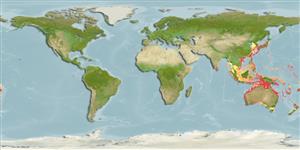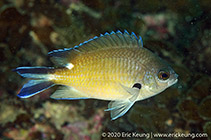Ajouter votre observation dans Fish Watcher
| Native range |

|
| This map was computer-generated and has not yet been reviewed. |
| Chromis fumea AquaMaps Data sources: GBIF OBIS |
Envoyez vos Photos et vidéos
Pictures | Images GoogleChromis fumea
Photo de Eric Keung@114°E Hong Kong Reef Fish Survey
Pictures | Images GoogleChromis fumea
Photo de Eric Keung@114°E Hong Kong Reef Fish Survey
Classification / Names Noms communs | Synonymes | Catalog of Fishes(Genre, Espèce) | ITIS | CoL | WoRMS | Cloffa
> Ovalentaria/misc (Various families in series Ovalentaria) > Pomacentridae (Damselfishes) > Chrominae
Etymology: Chromis: Greek, chromis = a fish, perhaps a perch (Ref. 45335).
More on author: Tanaka.
Etymology: Chromis: Greek, chromis = a fish, perhaps a perch (Ref. 45335).
More on author: Tanaka.
Environment: milieu / climate zone / depth range / distribution range Écologie
marin récifal; non migrateur; profondeur 3 - 30 m (Ref. 125611). Tropical
Distribution Pays | Zones FAO | Écosystèmes | Occurrences | Point map | Introductions | Faunafri
Western Pacific: restricted to Japan and Taiwan, with vagrants ranging southward to Malaysia.
Taille / Poids / Âge
Description synthétique Clés d'identification | Morphologie | Morphométrie
Épines dorsales (Total) : 13 - 14; Rayons mous dorsaux (Total) : 11 - 12; Épines anales: 2; Rayons mous anaux: 9 - 10. This species is distinguished by the following set of characters: D XIII-XIV,11-12 (usually 12); A II,9-10 (usually 10); pectoral-fin rays 18-20 (usually 19); pelvic-fin rays I,5; caudal-fin rays principal 15, branched 13; procurrent spiniform caudal-fin rays 2; tubed lateral-line scales 16-19 (usually 18-19); gill rakers 7-11 + 18-23, total rakers 26-33 (usually 26-29) (Ref. 125611).
Cross section: compressed.
Cross section: compressed.
Adults inhabit lagoon and seaward coral and rocky reefs (Ref. 9710). Prefer habitat consisting of boulder substrates or mixed rock, rubble, and sand, at depths between about 3 and 30 m (Ref. 125611). Oviparous, distinct pairing during breeding; eggs demersal and adhere to the substrate, and males guard and aerate the eggs (Ref. 205). Diurnal species (Ref. 54980; 113699).
Life cycle and mating behavior Maturité | Reproduction | Frai | Œufs | Fécondité | Larves
Oviparous, distinct pairing during breeding (Ref. 205). Eggs are demersal and adhere to the substrate (Ref. 205). Males guard and aerate the eggs (Ref. 205).
Référence principale
Upload your references | Références | Coordinateur : Allen, Gerald R. | Collaborateurs
Allen, G.R. and M.G. Allen, 2021. Two new species of Chromis (Teleostei: Pomacentridae) from northwestern Australia and the southwestern Pacific Ocean, previously part of C. fumea (Tanaka, 1917). J. Ocean Sci.Foundation 38:78-103. (Ref. 125611)
Statut dans la liste rouge de l'IUCN (Ref. 130435: Version 2024-2)
Préoccupation mineure (LC) ; Date assessed: 17 November 2010
CITES
Not Evaluated
Menace pour l'homme
Harmless
Utilisations par l'homme
FAO - Publication: search | FishSource |
Plus d'informations
Trophic ecology
Food items (preys)
Composition du régime alimentaire
Consommation alimentaire
Food rations
Prédateurs
Food items (preys)
Composition du régime alimentaire
Consommation alimentaire
Food rations
Prédateurs
Population dynamics
Paramètres de croissance
Max. ages / sizes
Length-weight rel.
Length-length rel.
Fréquences de longueurs
Mass conversion
Recrutement
Abondance
Paramètres de croissance
Max. ages / sizes
Length-weight rel.
Length-length rel.
Fréquences de longueurs
Mass conversion
Recrutement
Abondance
Life cycle
Reproduction
Maturité
Maturity/Gills rel.
Fécondité
Frai
Spawning aggregations
Œufs
Développement de l'œuf
Larves
Dynamique des populations larvaires
Reproduction
Maturité
Maturity/Gills rel.
Fécondité
Frai
Spawning aggregations
Œufs
Développement de l'œuf
Larves
Dynamique des populations larvaires
Physiology
Body composition
Nutrients
Consommation d'oxygène
Type de nage
Vitesse de nage
Visual pigments
Fish sound
Diseases & Parasites
Toxicity (LC50s)
Body composition
Nutrients
Consommation d'oxygène
Type de nage
Vitesse de nage
Visual pigments
Fish sound
Diseases & Parasites
Toxicity (LC50s)
Genetics
Génétique
Heterozygosity
Héritabilité
Génétique
Heterozygosity
Héritabilité
Human related
Aquaculture systems
Profils d'aquaculture
Souches
Ciguatera cases
Stamps, coins, misc.
Aquaculture systems
Profils d'aquaculture
Souches
Ciguatera cases
Stamps, coins, misc.
Outils
Bio-Quiz | E-book | Guide de terrain | Générateur de fréquences de longueur | Outil de dynamique de population | Carte par point | Classification Tree
| Catch-MSY |
Articles particuliers
Télécharger en XML
Sources Internet
AFORO (otoliths) | Aquatic Commons | BHL | Cloffa | BOLDSystems | Websites from users | FishWatcher | CISTI | Catalog of Fishes: Genre, Espèce | DiscoverLife | ECOTOX | FAO - Publication: search | Faunafri | Fishipedia | Fishtrace | GenBank: génôme, nucléotide | GloBI | Google Books | Google Scholar | Google | IGFA World Record | MitoFish | Bases de données nationales | Otolith Atlas of Taiwan Fishes | PubMed | Reef Life Survey | Socotra Atlas | Arbre de Vie | Wikipedia: aller à, chercher | World Records Freshwater Fishing | Zoological Record
Estimates based on models
Preferred temperature (Ref. 123201): 18.8 - 28.8, mean 27.2 °C (based on 636 cells).
Phylogenetic diversity index (Ref. 82804): PD50 = 0.5000 [Uniqueness, from 0.5 = low to 2.0 = high].
Bayesian length-weight: a=0.01259 (0.00571 - 0.02773), b=3.03 (2.84 - 3.22), in cm total length, based on LWR estimates for this (Sub)family-body shape (Ref. 93245).
Niveau trophique (Ref. 69278): 3.4 ±0.45 se; based on food items.
Résilience (Ref. 120179): Haut, temps minimum de doublement de population inférieur à 15 mois (Preliminary K or Fecundity.).
Fishing Vulnerability (Ref. 59153): Low vulnerability (10 of 100).
Nutrients (Ref. 124155): Calcium = 105 [61, 184] mg/100g; Iron = 0.862 [0.545, 1.367] mg/100g; Protein = 18.6 [17.5, 19.6] %; Omega3 = 0.175 [0.107, 0.283] g/100g; Selenium = 24.4 [13.4, 46.2] μg/100g; VitaminA = 253 [91, 669] μg/100g; Zinc = 1.68 [1.15, 2.32] mg/100g (wet weight);




